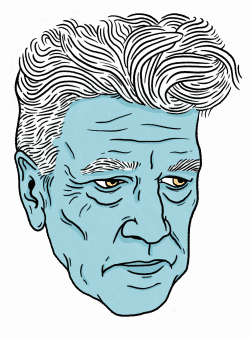The filmography of director David Lynch has left a mark on our culture that has completely changed how we think about horror, comedy and scripted television. After this explainer, you’ll be prepared to watch everything from Inland Empire to David Lynch Cooks Quinoa.
It’s hard to imagine how one director could directly influence both the baffling, post-ironic comedy of Tim and Eric Awesome Show, Great Job! and the sprawling mystery of Lost, but Lynch’s eccentric sensibilities have firmly ingrained themselves in the public consciousness in a way that seems all-encompassing.
In order to understand the strangeness of Lynch’s movies, it’s necessary to understand that Lynch himself is a deeply strange guy.
Lynch speaks in a friendly, nasal midwestern honk that seems at odds with his eerie artistic output. He curses frequently, but he always sounds like he’s still getting used to this whole swearing thing. He used to travel with five identical Woody Woodpecker dolls — Chucko, Buster, Pete, Bob and Dan — before he became convinced they held malicious energy.
 Film critics throw the word “Lynchian” around a lot to describe the director’s personality and sensibility, but it’s a term that seems to evade any kind of concrete definition. The simple answer is that Lynchian art juxtaposes seemingly mundane elements of American culture with the imagery and logic of dreams.
Film critics throw the word “Lynchian” around a lot to describe the director’s personality and sensibility, but it’s a term that seems to evade any kind of concrete definition. The simple answer is that Lynchian art juxtaposes seemingly mundane elements of American culture with the imagery and logic of dreams.
Plot and character development are perhaps the least interesting part of David Lynch’s work. Often times, events, people and places flow together the same way they do in dreams, making it hard to find a consistent throughline. As a director, he’s more concerned with depicting pure emotional forces rather than creating canonically consistent plots.
The best way to jump into Lynch’s world is through his most famous and most accessible work, Twin Peaks. The show is a genre-bending murder-mystery series that follows the denizens of a small Pacific Northwestern town as they grapple with the murder of troubled high school student Laura Palmer.
Of course, the central murder is just window dressing for a larger tale about ancient extra-dimensional observers locked in an unending battle between chaotic and peaceful forces. Twin Peaks’ contributions to television cinematography are astounding, but the series also holds up as a deceivingly subversive comedy and is genuinely scary at times.
Twin Peaks serves as a solid introduction to Lynch, but Mulholland Drive is his masterwork. The film is overflowing with poignant scenes, odd-ball performances and a rogue’s gallery of truly grotesque Lynchian villains. It somehow contains both the finest jump scare ever put to film and an absolutely bonkers meta-textual meditation on diegetic sound.
Mulholland Drive gets a bad rap for being pretentious, and while it could be construed that way, it’s always struck me as Lynch’s most personal and emotionally honest film. It seems obtuse to try to spin the film’s dream logic into a coherent plot, but I’m not convinced that the film’s message is really that complicated.
Famously, Lynch billed the film as simply “a love story in the city of dreams.” It just happens to be a love story that features cameos from an evil cowboy who might be the devil and a ghoul who lives behind a dumpster. That’s Lynch’s style, though — to simultaneously communicate an idea in its purest form and obscure it behind layers of abstraction.
As for what to watch next, Eraserhead is a nightmarish silent-film homage that owes as much to Chaplin as it does to Nosferatu, and last year’s Twin Peaks: The Return is a cheap and easy way to turn your brain inside out. Just steer clear of Dune — we don’t talk about Dune.
Lynch’s filmography can be frustrating, but it can also be immensely rewarding if you put enough time into it. Worst case scenario, you might learn a pretty good quinoa recipe from the man.
—
Cole Chretien / Culture Editor
Graphic: Jaymie Stachyruk / Graphics Editor